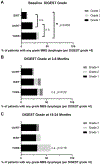Swallowing After Primary TORS and Unilateral or Bilateral Radiation for Low- to Intermediate-Risk Tonsil Cancer
- PMID: 34784256
- PMCID: PMC9108124
- DOI: 10.1177/01945998211059967
Swallowing After Primary TORS and Unilateral or Bilateral Radiation for Low- to Intermediate-Risk Tonsil Cancer
Abstract
Objective: The primary course of treatment for patients with low- to intermediate-risk tonsil cancer has evolved with a shift toward primary transoral robotic surgery (TORS) or radiation therapy (RT). While favorable outcomes have been reported after deintensification via unilateral TORS or RT (uniRT), comparisons of functional outcomes between these treatments are lacking. We compared clinical outcomes (Dynamic Imaging Grade of Swallowing Toxicity [DIGEST] and feeding tube [FT]) and patient-reported swallowing outcomes (MD Anderson Dysphagia Inventory [MDADI]) based on primary treatment strategy: TORS, uniRT, or bilateral RT (biRT).
Study design: Secondary analysis of prospective cohort.
Setting: Single institution.
Methods: The study sample comprised 135 patients with HPV/p16+ T1-T3, N0-2b (American Joint Committee on Cancer, seventh edition), N0-1 (eighth edition) squamous cell carcinoma of the tonsil were sampled from a prospective registry. Modified barium swallow studies graded per DIGEST, FT placement and duration, and MDADI were collected.
Results: Baseline DIGEST grade significantly differed among treatment groups, with higher dysphagia prevalence in the TORS group (34%) vs the biRT group (12%, P = .04). No significant group differences were found in DIGEST grade or dysphagia prevalence at subacute and longitudinal time points (P = .41). Mean MDADI scores were similar among groups at baseline (TORS, 92; uniRT, 93; biRT, 93; P = .90), subacute (TORS, 83; uniRT, 88; biRT, 82; P = .38) and late time points (TORS, 86; uniRT, 86; biRT, 87; P = .99). FT placement and duration significantly differed among primary treatment groups (FT [median days]: TORS, 89% [3]; uniRT, 8% [82]; biRT, 37% [104]; P < .001).
Conclusion: While TORS and uniRT offer optimal functional outcomes related to dysphagia, results suggest that no measurable clinician-graded or patient-reported differences in swallow outcomes exist among these primary treatment strategies and biRT. Aside from baseline differences that drive treatment selection, differences in FT rate and duration by primary treatment strategy likely reflect diverse toxicities beyond dysphagia.
Keywords: dysphagia; head and neck cancer; radiation; surgery; unilateral.
Figures




References
-
- Parsons JT, Mendenhall WM, Stringer SP, et al. Squamous cell carcinoma of the oropharynx: surgery, radiation therapy, or both. Cancer. 2002;94(11):2967–2980. - PubMed
-
- Ragin CC, Taioli E. Survival of squamous cell carcinoma of the head and neck in relation to human papillomavirus infection: review and meta-analysis. Int J Cancer. 2007;121(8):1813–1820. - PubMed
-
- Fakhry C, Westra WH, Li S, et al. Improved survival of patients with human papillomavirus–positive head and neck squamous cell carcinoma in a prospective clinical trial. J Natl Cancer Inst. 2008;100(4):261–269. - PubMed
-
- Lazarus CL, Ganz C, Ru M, Miles BA, Kotz T, Chai RL. Prospective instrumental evaluation of swallowing, tongue function, and QOL measures following transoral robotic surgery alone without adjuvant therapy. Head Neck. 2019;41(2):322–328. - PubMed
Publication types
MeSH terms
Grants and funding
LinkOut - more resources
Full Text Sources
Medical

